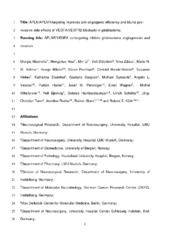Targeting APLN/APLNR improves antiangiogenic efficiency and blunts proinvasive side effects of VEGFA/VEGFR2 blockade in glioblastoma
Mastrella, Giorgia; Hou, Mengzhuo; Li, Min; Stöcklein, Veit M.; Zdouc, Nina; Volmar, Marie N.M.; Miletic, Hrvoje; Reinhard, Sören; Herold-Mende, Christel C.; Kleber, Susanne; Eisenhut, Katharina; Gargiulo, Gaetano; Synowitz, Michael; Vescovi, Angelo L.; Harter, Patrick N.; Penninger, Josef M.; Wagner, Ernst; Mittelbronn, Michel; Bjerkvig, Rolf; Hambardzumyan, Dolores; Schüller, Ulrich; Tonn, Jörg Christian; Radke, Josefine; Glass, Rainer; Kälin, Roland E.
Peer reviewed, Journal article
Accepted version
Permanent lenke
https://hdl.handle.net/1956/21991Utgivelsesdato
2019Metadata
Vis full innførselSamlinger
Originalversjon
https://doi.org/10.1158/0008-5472.can-18-0881Sammendrag
Antiangiogenic therapy of glioblastoma (GBM) with bevacizumab, a VEGFA-blocking antibody, may accelerate tumor cell invasion and induce alternative angiogenic pathways. Here we investigate the roles of the proangiogenic apelin receptor APLNR and its cognate ligand apelin in VEGFA/VEGFR2 antiangiogenic therapy against distinct subtypes of GBM. In proneural GBM, apelin levels were downregulated by VEGFA or VEGFR2 blockade. A central role for apelin/APLNR in controlling GBM vascularization was corroborated in a serial implantation model of the angiogenic switch that occurs in human GBM. Apelin and APLNR are broadly expressed in human GBM, and knockdown or knockout of APLN in orthotopic models of proneural or classical GBM subtypes significantly reduced GBM vascularization compared with controls. However, reduction in apelin expression led to accelerated GBM cell invasion. Analysis of stereotactic GBM biopsies from patients as well as from in vitro and in vivo experiments revealed increased dissemination of APLNR-positive tumor cells when apelin levels were reduced. Application of apelin-F13A, a mutant APLNR ligand, blocked tumor angiogenesis and GBM cell invasion. Furthermore, cotargeting VEGFR2 and APLNR synergistically improved survival of mice bearing proneural GBM. In summary, we show that apelin/APLNR signaling controls GBM angiogenesis and invasion and that both pathologic features are blunted by apelin-F13A. We suggest that apelin-F13A can improve the efficiency and reduce the side effects of established antiangiogenic treatments for distinct GBM subtypes.
